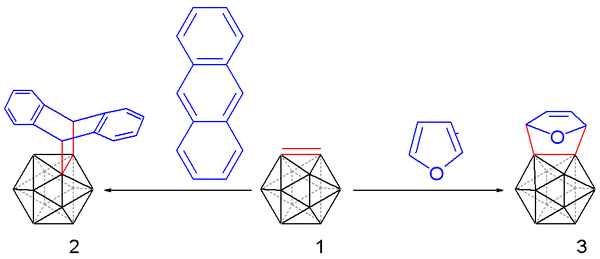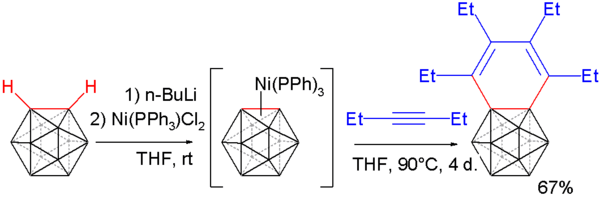Carborane
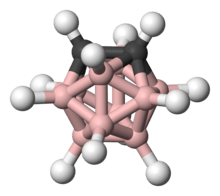
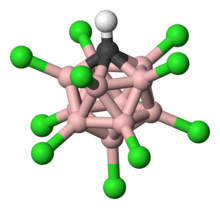
hydrogen − white,
chlorine − green,
boron − pink,
carbon − black.
A carborane is a cluster composed of boron, carbon and hydrogen atoms. Like many of the related boranes, these clusters are polyhedra and are similarly classified as closo-, nido-, arachno-, hypho-, etc. based on whether they represent a complete (closo-) polyhedron, or a polyhedron that is missing one (nido-), two (arachno-), or more vertices. Carboranes are a notable example of heteroboranes.
Interesting examples of carboranes are the extremely stable icosahedral closo-carboranes.[1] These boron-rich clusters exhibit unique organomimetic properties with chemical reactivity matching classical organic molecules, yet structurally similar to metal-based inorganic and organometallic species[2]
A prominent example is the charge-neutral C2B10H12 or o-carborane with the prefix o derived from ortho, which has been explored for use in a wide range of applications from heat-resistant polymers to medical applications. The electronic structure of these compounds is best described by Wade-Mingos rules for cluster molecules. Another important carborane is carborane acid, a chlorinated superacid H(CHB11Cl11), which has an anion structure shown at right.
Dicarbadodecaborane
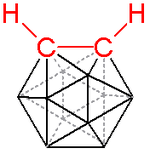
The most heavily studied carborane is C2B10H12, m. p. 320 °C. It is often prepared from the reaction of acetylene with decaborane. A variation on this method entails the use of dimethyl acetylenedicarboxylate to give C2B10H10(CO2C H3)2, which can be degraded to the C2B10H12.[3]
History
The 1,2-closo-dicarbadodecaboranes (usually simply called carboranes), were reported simultaneously by groups at Olin Corporation and the Reaction Motors Division of Thiokol Chemical Corporation working under the U.S. Air Force and published in 1963.[4] Heretofore, decaborane derivatives were thought to be thermally unstable and reactive with air and water. These groups demonstrated the unprecedented stability of the 1,2-closo-dodecaborane group, presented a general synthesis, described the transformation of substituents without destroying the carborane cluster, and demonstrated the ortho to meta isomerization.

Isomerization of dicarboranes
Ortho dicarborane is the kinetic product from the addition of acetylenes to decarborane precursors. Upon heating at 420 °C, the ortho dicarborane rearranges to the meta isomer. Upon further heating, one obtains para-carborane. Like arenes, carboranes also undergo electrophilic aromatic substitution.
 Thermal rearrangement of o-dicarborane to its meta- and para-isomers (CH vertex indicated with black spheres).
Thermal rearrangement of o-dicarborane to its meta- and para-isomers (CH vertex indicated with black spheres).
Dicarbollide
Numerous studies have been made on derivatives of the so-called dicarbollide anion, [B9C2H11]2−. The first metal dicarbollide complex was discovered by M. Frederick Hawthorne and co-workers in 1965.[5] This anion forms sandwich compounds, referred to as bis(dicarbollides), with many metal ions and some exist in otherwise unusual oxidation states. The dianion is a nido cluster prepared by degradation of the parent dicarborane. For many practical syntheses, the monoprotonated dicarbollide salt B9C2H−
12 is isolated as its potassium salt:[6]
- B10C2H12 + 3 CH3OH + KOH → KB9C2H12 + B(OCH3)3 + H2O + H2
The monopotassium salt can then deprotonated with strong base:
- KB10C2H12 + KH → K2B9C2H11 + H2
Bis(dicarbollides) often exhibit properties very different from their metallocene surrogates. For example, Ni-based bis(dicarbollide) cluster can be observed for the rare Ni(IV) oxidation state of nickel. Some notable examples of potential applications of these complexes include catalysis,[7] ion-exchange materials for radioactive waste management, biologically active protease inhibitors, and chemically inert redox shuttles for dye-sensitized solar cells (DSSCs).[8]
Carborynes
Carboryne, or 1,2-dehydro-o-carborane, is an unstable derivative of ortho-carborane with the formula B10C2H10. The hydrogen atoms on the C2 unit in the parent o-carborane are missing. The compound resembles and is isolobal with benzyne.[9][10][11] A carboryne compound was first generated in 1990 starting from o-carborane. The hydrogen atoms connected to carbon are removed by n-butyllithium in tetrahydrofuran and the resulting lithium dianion is reacted with bromine at 0 °C to form the bromo monoanion.
Heating the reaction mixture to 35 °C releases carboryne, which can subsequently be trapped with suitable dienes:
such as anthracene (to afford a triptycene-like molecule) and furan in 10 to 25% chemical yield.
Carborynes react with alkynes to benzocarboranes [12][13] in an adaptation of the above described procedure. O-carborane is deprotonated with n-butyllithium as before and then reacted with dichloro-di(triphenylphosphino) nickel to a nickel coordinated carboryne. This compound reacts with 3-hexyne in an alkyne trimerization to the benzocarborane.
Single crystal X-ray diffraction analysis of this compound shows considerable bond length alternation in the benzene ring (164.8 pm to 133.8 pm) ruling out aromaticity.
Research
Carboranes have been explored as a source of boron in boron neutron capture therapy.[14] They have also been examined in structural studies in crystallography.[15]
Carboranes have been used to make solid superacids. Solid superacid catalysts alleviate the need to dispose of spent acids, thus providing a significant environmental advantage over dissolved acids.[16] The carborane superacid H(CHB11Cl11)[17] is one million times stronger than sulfuric acid.[18][19] The reason for this high acidity is that the acid anion CHB11Cl−
11 is very stable and substituted with electronegative substituents. H(CHB11Cl11) is the only acid known to protonate C60 fullerene without decomposing it.[20] Additionally, it is the only known anion capable of forming a stable, isolable salt with protonated benzene, C6H+
7.
In coordination chemistry carboranes can be used as unique bulky ligand scaffolds. It was recently demonstrated, that the same carboranyl moiety can act either as strongly electron-withdrawing or electron-donating substituent, depending on the positional attachment of the cluster to the heteroatom.[21][22]
See also
References
- ↑ Jemmis, E. D. (1982). "Overlap control and stability of polyhedral molecules. Closo-Carboranes". Journal of the American Chemical Society. 104 (25): 7017–7020. doi:10.1021/ja00389a021.
- ↑ Spokoyny, A. M. (2013). "New ligand platforms featuring boron-rich clusters as organomimetic substituents". Pure and Applied Chemistry. 85 (5): 903–919. doi:10.1351/PAC-CON-13-01-13.
- ↑ Kutal, C. R.; Owen, D. A.; Todd, L. J. (1968). "Closo-1,2-dicarbadodecaborane(12)". Inorganic Syntheses. 11: 19–23. doi:10.1002/9780470132425.ch5. ISBN 978-0-470-13242-5.
- ↑ Heying, T. L.; Ager, J. W.; Clark, S. L.; Mangold, D. J.; Goldstein, H. L.; Hillman, M.; Polak, R. J.; Szymanski, J. W. (1963). "A New Series of Organoboranes. I. Carboranes from the Reaction of Decaborane with Acetylenic Compounds". Inorganic Chemistry. 2 (6): 1089–1092. doi:10.1021/ic50010a002.Schroeder, H.; Heying, T. L.; Reiner, J. R. (1963). "A New Series of Organoboranes. II. The Chlorination of 1,2-Dicarbaclosododecaborane(12)". Inorganic Chemistry. 2 (6): 1092–1096. doi:10.1021/ic50010a003.Heying, T. L.; Ager, J. W.; Clark, S. L.; Alexander, R. P.; Papetti, S.; Reid, J. A.; Trotz, S. I. (1963). "A New Series of Organoboranes. III. Some Reactions of 1,2-Dicarbaclosododecaborane(12) and its Derivatives". Inorganic Chemistry. 2 (6): 1097–1105. doi:10.1021/ic50010a004.Papetti, S.; Heying, T. L. (1963). "A New Series of Organoboranes. IV. The Participation of the 1,2-Dicarbaclosododecaborane(12) Nucleus in Some Novel Heteratomic Ring Systems". Inorganic Chemistry. 2 (6): 1105–1107. doi:10.1021/ic50010a005.Fein, M. M.; Bobinski, J.; Mayes, N.; Schwartz, N.; Cohen, M. S. (1963). "Carboranes. I. The Preparation and Chemistry of 1-Isopropenylcarborane and its Derivatives (a New Family of Stable Closoboranes)". Inorganic Chemistry. 2 (6): 1111–1115. doi:10.1021/ic50010a007.Fein, M. M.; Grafstein, D.; Paustian, J. E.; Bobinski, J.; Lichstein, B. M.; Mayes, N.; Schwartz, N. N.; Cohen, M. S. (1963). "Carboranes. II. The Preparation of 1- and 1,2-Substituted Carboranes". Inorganic Chemistry. 2 (6): 1115–1119. doi:10.1021/ic50010a008.Grafstein, D.; Bobinski, J.; Dvorak, J.; Smith, H.; Schwartz, N.; Cohen, M. S.; Fein, M. M. (1963). "Carboranes. III. Reactions of the Carboranes". Inorganic Chemistry. 2 (6): 1120–1125. doi:10.1021/ic50010a009.Grafstein, D.; Bobinski, J.; Dvorak, J.; Paustian, J. E.; Smith, H. F.; Karlan, S.; Vogel, C.; Fein, M. M. (1963). "Carboranes. IV. Chemistry of Bis-(1-carboranylalkyl) Ethers". Inorganic Chemistry. 2 (6): 1125–1128. doi:10.1021/ic50010a010.Grafstein, D.; Dvorak, J. (1963). "Neocarboranes, a New Family of Stable Organoboranes Isomeric with the Carboranes". Inorganic Chemistry. 2 (6): 1128–1133. doi:10.1021/ic50010a011.
- ↑ Hawthorne, M. F.; Young, D. C.; Wegner, P. A. (1965). "Carbametallic Boron Hydride Derivatives. I. Apparent Analogs of Ferrocene and Ferricinium Ion". Journal of the American Chemical Society. 87 (8): 1818–1819. doi:10.1021/ja01086a053.
- ↑ Plešek, J.; Heřmánek, S.; Štíbr, B. (1983). "Potassium dodecahydro-7,8-dicarba-nido-undecaborate(1-), k[7,8-C2B9H12], intermediates, stock solution, and anhydrous salt". Inorganic Syntheses. 22: 231–234. doi:10.1002/9780470132531.ch53.
- ↑ Crowther, D. J.; Baenziger, N. C.; Jordan, R. F. (1991). "Group 4 metal dicarbollide chemistry. Synthesis, structures and reactivity of electrophilic alkyl complexes (Cp*)(C2B9H11)M(R), M = Hf, Zr". Journal of the American Chemical Society. 113 (4): 1455–1457. doi:10.1021/ja00004a080.
- ↑ Spokoyny, A. M.; Li, T. C.; Machan, C. W.; Farha, O. K.; She, C.; Stern, C. L.; Marks, T. J.; Hupp, J. T.; Mirkin, C. A. (2010). "Electronic Tuning of Nickel-Based Bis(dicarbollide) Redox Shuttles in Dye-Sensitized Solar Cells". Angewandte Chemie International Edition. 49 (31): 5339–5343. doi:10.1002/anie.201002181.
- ↑ Gingrich, H. L.; Ghosh, T.; Huang, Q.; Jones, M. (1990). "1,2-Dehydro-o-carborane". Journal of the American Chemical Society. 112 (10): 4082–4083. doi:10.1021/ja00166a080.
- ↑ Jemmis, E. D.; Kiran, B. (1997). "Structure and Bonding in B10X2H10 (X = C and Si). The Kinky Surface of 1,2-Dehydro-o-Disilaborane". Journal of the American Chemical Society. 119 (19): 4076–4077. doi:10.1021/ja964385q.
- ↑ Kiran, B.; Anoop, A.; Jemmis, E. D. (2002). "Control of Stability through Overlap Matching: closo-Carboranes and closo-Silaboranes". Journal of the American Chemical Society. 124 (16): 4402–4407. doi:10.1021/ja016843n.
- ↑ Deng, L.; Chan, H.-S.; Xie, Z. (2006). "Nickel-Mediated Regioselective [2 + 2 + 2] Cycloaddition of Carboryne with Alkynes". Journal of the American Chemical Society. 128 (24): 7728–7729. doi:10.1021/ja061605j. PMID 16771473.
- ↑ Jemmis, E. D.; Anoop, A. (2004). "Theoretical Study of the Insertion Reactions of Benzyne- and Carboryne- Ni Complexes" (pdf). Maui High Performance Computing Center Application Briefs. Air Force Maui Optical & Supercomputing Site (AMOS). 2004: 51.
- ↑ Soloway, A. H.; Tjarks, W.; Barnum, B. A.; Rong, F.-G.; Barth, R. F.; Codogni, I. M.; Wilson, J. G. (1998). "The Chemistry of Neutron Capture Therapy". Chemical Reviews. 98 (4): 1515–1562. doi:10.1021/cr941195u. PMID 11848941.
- ↑ Zhang, D. P.; Dou, J. M.; Li, D. C.; Wang, D. Q. (2007). "Di-μ-chlorido-bis{[1,2-bis(diphenylphosphino)-1,2-dicarba-closo-dodecaborane-κ2P,P']silver(I)} dichloromethane disolvate". Acta Crystallographica E. 63 (4): m1086–m1088. doi:10.1107/S1600536807007088.
- ↑ Olah, G. A. (2001). A Life of Magic Chemistry: Autobiographical Reflections of a Nobel Prize Winner. John Wiley and Sons. p. 105. ISBN 0-471-15743-0.
- ↑ Note that the image the acidic proton is not the one bonded to the carborane but that it is the counterion not displayed
- ↑ Olah, G. A.; Prakash, G. K. S.; Sommer, J.; Molnar, A. (2009). Superacid Chemistry (2nd ed.). Wiley. p. 41. ISBN 978-0-471-59668-4.
- ↑ That is, the concentration of H+ in a solution of the carborane superacid is a million times higher than in a solution of sulfuric acid.
- ↑ Christopher A. Reed "Myths about the Proton. The Nature of H+ in Condensed Media" Acc. Chem. Res., 2013, vol. 46, pp 2567–2575. doi:10.1021/ar400064q
- ↑ Spokoyny, A. M.; Machan, C. W.; Clingerman, D. J.; Rosen, M. S.; Wiester, M. J.; Kennedy, R. D.; Stern, C. L.; Sarjeant, A. A.; Mirkin, C. A. (2011). "A coordination chemistry dichotomy for icosahedral carborane-based ligands". Nature Chemistry. 3 (8): 590–596. Bibcode:2011NatCh...3..590S. doi:10.1038/nchem.1088. PMID 21778977.
- ↑ Spokoyny, A. M.; Lewis, C. D.; Teverovskiy, G.; Buchwald, S. L. (2012). "Extremely Electron-Rich, Boron-Functionalized, Icosahedral Carborane-Based Phosphinoboranes". Organometallics. 31 (24): 8478–8481. doi:10.1021/om301116x. PMID 23667288.

